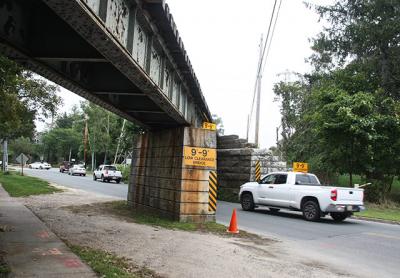Village Train Trestles Will Get a Big Lift

What is expected to be a yearlong project to raise the Long Island Rail Road trestles that cross North Main Street and Accabonac Road in East Hampton Village will begin next month, the village board was told on Friday.
Hector Garcia, a railroad official, told the board that the trestles, which are often struck and damaged by trucks, would be raised from 11 to 14 feet high with the installation of new bridge structures. The track bed will also have to be raised, he said. Retaining walls will be constructed, on L.I.R.R. property, on either side of the tracks.
The work will mostly be confined to the construction areas, he said, but the L.I.R.R. will need access to some residential properties east of the trestles in order to reach its property.
Clearing of vegetation along the tracks will commence next month, Mr. Garcia said, “and then they start prepping the area for the retaining walls.” That work will not affect traffic except during delivery of materials, he said, “but there shouldn’t be any major disruptions.” It will happen on weekdays between 7 a.m. and 3 p.m. “We don’t anticipate overnight or weekend work for the wall construction,” which would span October to around May 2018, he said.
The trestles will be installed next fall, and that work will be more disruptive, Mr. Garcia said. It will consist of removal of the existing trestles and tracks, regrading of land, and installation of new support infrastructure. “All that has to be done at the same time,” he said. Each trestle replacement will take about 10 days, he said, and work will be done around the clock. The roads will be closed during construction.
The trestle over North Main Street will be replaced first, Mr. Garcia said, and all work will be completed by November 2018.
Board members questioned the L.I.R.R. officials on the overnight construction periods and the aesthetics of the new structures. “What kind of noise are we talking about?” asked Barbara Borsack. “We have a lot of residents who live on those tracks — I’m one of them. The idea of being awake for a month or more, listening to that noise, is disconcerting. Is that going to keep us up all night?”
Apart from the crane that will set the new structures on their bearings, noise will be limited, responded Paul Jones, the L.I.R.R.’s principal engineer for structures. “Setting the bridge is the easy part,” he said.
In each 10-day period, “the majority of that work is grading the track back down to the crossing so that you get the proper profile,” Mr. Jones said. There will be little excavation, and no pile-driving, he said. “It’s about 1,000 feet of retaining wall, so there will be noise, but we’re very cognizant” of sensitivities to noise, he said. “This is not our first job in a residential community.”
“If it costs them a little more to do it over a longer period of time and be less disruptive, I think we’d prefer that,” Ms. Borsack said.
Likewise, board members said that the L.I.R.R. should heed its desire to preserve the village’s character, regardless of cost. Of chief concern was news that the new bridges would be concrete. “Would you be thinking of mixing any color in with the concrete so it might match the current abutments, which are quite dark?” Arthur Graham asked.
Due to the relatively modest scope of the project, none of the 17 vendors solicited were willing to consider coloring the concrete, the officials said. The concrete is mixed in a vat, Mr. Jones said. “They don’t just have the railroad job; they have the railroad’s job, Job B, C, D, etc.” Adding color to the vat would render the concrete unusable for other jobs, he explained. One vendor quoted a ninefold increase in cost to color the concrete, he said. Staining the concrete after construction could be explored, he added.
Mayor Paul F. Rickenbach asked the officials to “get whatever pertinent paperwork relates to that specifically, to the office of the village administrator. Allow us to cull that information,” after which village officials will consult with state officials, possibly including Gov. Andrew M. Cuomo.
A less controversial component of the project is the renovation of the station building on Railroad Avenue. The L.I.R.R. is working with Robert Hefner, the village’s director of historic services, on a plan to restore the structure to its original look. New amenities such as WiFi, charging stations, new lighting, and digital signage will be added, Mr. Garcia said. That work will begin next year.
The L.I.R.R. officials pledged to take the board’s concerns to their superiors and return with a plan that addresses them. “You’ve been class proponents,” the mayor told them. “Working together on some of these fine issues, we can come to some resolution. But more importantly, you’re a compliment to your profession.”
In the meeting’s other transportation-related news, Scott Fithian, the superintendent of public works, told the board that the State Department of Transportation issued a permit last Thursday for construction of a roundabout at Buell and Toilsome Lanes. The work will commence in about two weeks.
Also at the meeting, the board voted to prohibit parking at all times on the east side of North Main Street between the intersection with Main Street and the railroad trestle.
Becky Hansen, the village administrator, told the board of plans to add three parking spaces to the lot shared by Village Hall with the Dayton, Ritz, and Osborne insurance agency. It was determined, after a recent repaving and drainage improvement project that resulted in the loss of one space, that parking there is inadequate, she said. Because the lot is in the historic district, the proposal requires approval by the design review board.
